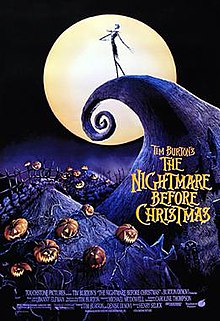| The Nightmare Before Christmas | |
|---|---|
 Theatrical release poster | |
| Directed by | Henry Selick |
| Screenplay by | Caroline Thompson |
| Adaptation by | Michael McDowell |
| Based on | Story and Characters by Tim Burton |
| Produced by |
|
| Starring | |
| Cinematography | Pete Kozachik |
| Edited by | Stan Webb |
| Music by | Danny Elfman |
Production companies | |
| Distributed by | Buena Vista Pictures Distribution[2] |
Release dates |
|
Running time | 76 minutes[3] |
| Country | United States |
| Language | English |
| Budget | $18 million[4] |
| Box office | $107.8 million[5] |
The Nightmare Before Christmas (also known as Tim Burton's The Nightmare Before Christmas) is a 1993 American Halloween-Christmas gothic stop motion animated musical fantasy film[6] directed by Henry Selick in his feature directorial debut and produced and conceived by Tim Burton. It tells the story of Jack Skellington, the King of "Halloween Town", who stumbles upon "Christmas Town" and schemes to take over the holiday. Danny Elfman wrote the songs and score and provided the singing voice of Jack.[7] The principal voice cast includes Chris Sarandon, Catherine O'Hara, William Hickey, Ken Page, Paul Reubens, Glenn Shadix and Ed Ivory.
The Nightmare Before Christmas originated from a poem written by Burton in 1982 while he was working as an animator at Walt Disney Productions. With the critical success of Vincent that same year, Burton began to consider developing the film as either a short film or a half-hour television special, to no avail. Over the years, Burton's thoughts regularly returned to the project, and, in 1990, he made a development deal with Walt Disney Studios. Production started in July 1991 in San Francisco; Disney initially released the film through the Touchstone Pictures label because the studio believed the film would be "too dark and scary for kids".[1]
The Nightmare Before Christmas premiered at the New York Film Festival on October 9, 1993, and was given a limited release on October 13, before its wide theatrical release on October 29. The film was met with commercial and critical success upon release, earning praise for its animation, particularly the innovation of stop-motion as an art form, as well as its characters, songs, and score. While initially a modest box office hit, it has since garnered a large cult following and is widely regarded as one of the greatest animated films of all time.[8][9][10][11][12] It was nominated for the Academy Award for Best Visual Effects, a first for an animated film, but lost to Jurassic Park.[13] Thirteen years after its initial release, the film was reissued by Walt Disney Pictures and was re-released annually in Disney Digital 3-D from 2006 until 2010.
In 2023, the film was selected for preservation in the United States National Film Registry by the Library of Congress as being "culturally, historically or aesthetically significant."[14]
- ^ a b Mendelson, Scott (October 15, 2013). "'Nightmare Before Christmas' Turns 20: From Shameful Spawn To Disney's Pride". Forbes. Archived from the original on December 23, 2013. Retrieved December 14, 2013.
- ^ a b "The Nightmare Before Christmas". American Film Institute. Archived from the original on December 26, 2020. Retrieved September 3, 2020.
- ^ "The Nightmare Before Christmas (PG)". British Board of Film Classification. March 18, 1994. Archived from the original on December 20, 2016. Retrieved December 7, 2016.
- ^ Cite error: The named reference
Elfmanwas invoked but never defined (see the help page). - ^ "Tim Burton's The Nightmare Before Christmas (1993)". Box Office Mojo. Retrieved November 3, 2024.
- ^ Gonzales, Beth (November 10, 2020). "Review: 'The Nightmare Before Christmas' Embodies the Holiday Spirit". Pepperdine Graphic. Retrieved October 28, 2024.
- ^ Ng, David (October 24, 2015). "Danny Elfman can relate to 'Nightmare Before Christmas' hero Jack Skellington". Los Angeles Times. Archived from the original on October 14, 2019. Retrieved October 14, 2019.
- ^ Vonder, Holly (January 21, 2022). "The 20 Best Animated Movies of All Time". CBR. Archived from the original on August 26, 2023. Retrieved November 22, 2023.
- ^ Bagamery, Jonathan (December 25, 2022). "15 Best Christmas Horror Movies". CBR. Archived from the original on September 9, 2023. Retrieved November 22, 2023.
- ^ Aguilar, Carlos (October 25, 2023). "'The Nightmare Before Christmas': A Hit That Initially Unnerved Disney". The New York Times. Archived from the original on October 30, 2023. Retrieved November 22, 2023.
- ^ VanDenburgh, Barbara. "Top 10 stop-motion animated movies". The Arizona Republic. Archived from the original on October 30, 2023. Retrieved November 22, 2023.
- ^ Hathaway, Benjamin; Mahler, Matt (October 12, 2023). "30 Best Halloween Movies of All Time". MovieWeb. Archived from the original on October 31, 2023. Retrieved November 22, 2023.
- ^ "'Jurassic Park,' another Spielberg movie, also has good night with 3 awards". The Orlando Sentinel. March 22, 1994. p. 6. Archived from the original on September 21, 2022. Retrieved September 21, 2022 – via Newspapers.com.

- ^ Saperstein, Pat (December 13, 2023). "'Home Alone,' 'Terminator 2,' '12 Years a Slave' Among 25 Titles Joining National Film Registry". Variety. Archived from the original on December 13, 2023. Retrieved December 13, 2023.
Cite error: There are <ref group=lower-alpha> tags or {{efn}} templates on this page, but the references will not show without a {{reflist|group=lower-alpha}} template or {{notelist}} template (see the help page).